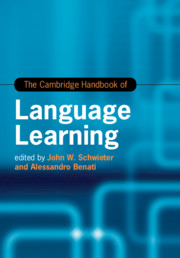Book contents
- The Cambridge Handbook of Language Learning
- Cambridge Handbooks in Language and Linguistics
- The Cambridge Handbook of Language Learning
- Copyright page
- Contents
- Figures
- Tables
- Contributors
- Acknowledgements
- Introduction
- Part I Theories
- 1 Formal Linguistic Approaches to Adult L2 Acquisition and Processing
- 2 Cognitive Approaches to Second Language Acquisition
- 3 The Qualitative Science of Vygotskian Sociocultural Psychology and L2 Development
- 4 Theoretical Frameworks in L2 Acquisition
- Part II Methods
- Part III Skill Development
- Part IV Individual Differences
- Part V Pedagogical Interventions and Approaches
- Part VI Context and Environment
- Part VII Moving Forward
- Index
- References
4 - Theoretical Frameworks in L2 Acquisition
from Part I - Theories
Published online by Cambridge University Press: 25 June 2019
- The Cambridge Handbook of Language Learning
- Cambridge Handbooks in Language and Linguistics
- The Cambridge Handbook of Language Learning
- Copyright page
- Contents
- Figures
- Tables
- Contributors
- Acknowledgements
- Introduction
- Part I Theories
- 1 Formal Linguistic Approaches to Adult L2 Acquisition and Processing
- 2 Cognitive Approaches to Second Language Acquisition
- 3 The Qualitative Science of Vygotskian Sociocultural Psychology and L2 Development
- 4 Theoretical Frameworks in L2 Acquisition
- Part II Methods
- Part III Skill Development
- Part IV Individual Differences
- Part V Pedagogical Interventions and Approaches
- Part VI Context and Environment
- Part VII Moving Forward
- Index
- References
Summary
It is important to distinguish between a theory and the hypotheses that are derived from it, on the one hand, and a theoretical framework on the other. The crucial criterion for judging a theory, in addition to its explanatory value, is its ability to make useful predictions. A framework functions at a higher level of abstraction. The level can vary between a narrow, “local” framework restricted to a well-specified research domain and one that has a wider coverage, ending up with frameworks that also facilitate interdisciplinary research projects. What all frameworks have in common is that they contain some commitments that cannot be significantly altered: this is the framework’s metatheory. Then there are the areas where variation is perfectly possible, allowing researchers to carry out many alternative applications of the metatheory that defines that particular framework.
- Type
- Chapter
- Information
- The Cambridge Handbook of Language Learning , pp. 84 - 108Publisher: Cambridge University PressPrint publication year: 2019
References
- 5
- Cited by



